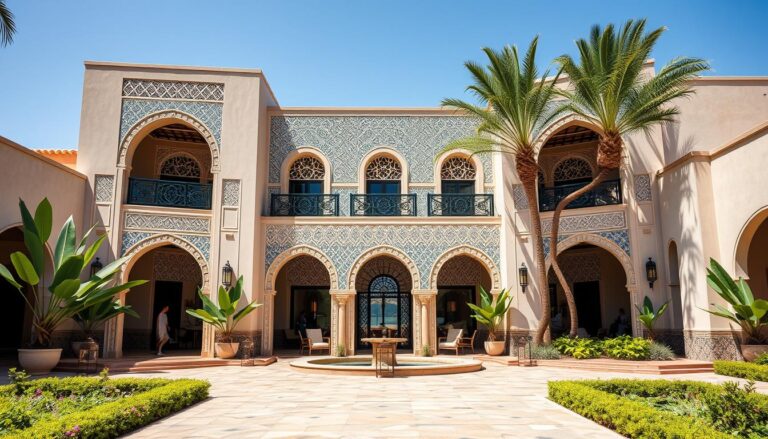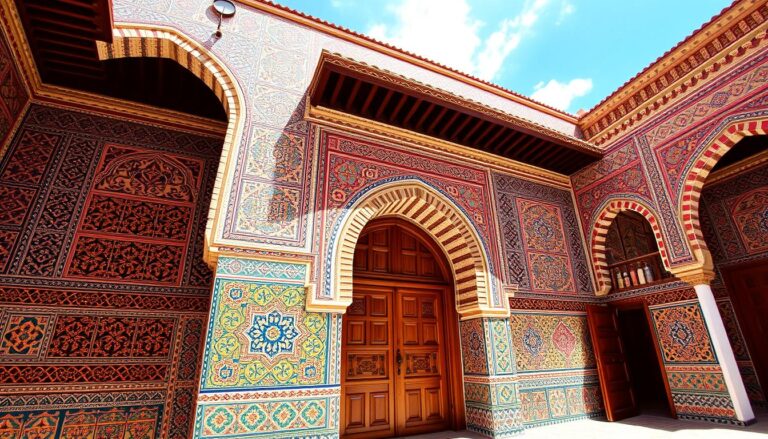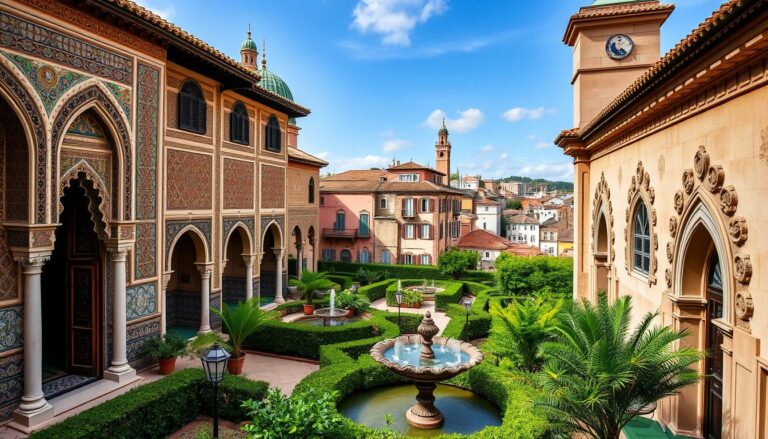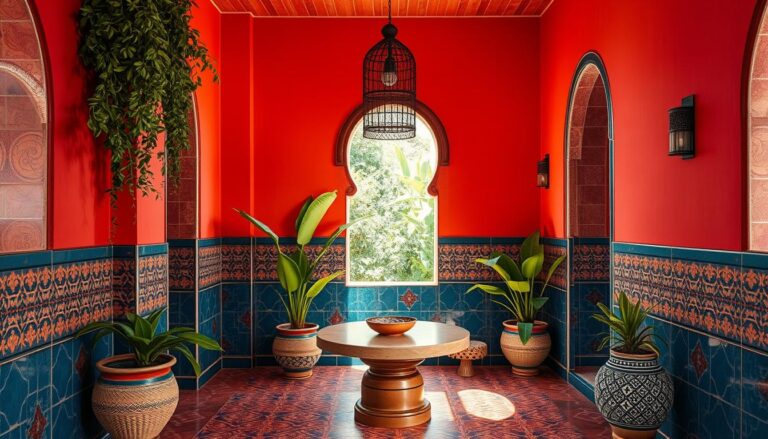Moroccan architecture is deeply rooted in the Atlas Mountains’ dramatic landscapes and rich culture. The ancient kasbahs and intricate mud-brick structures show a strong bond with nature. They also reflect a mix of diverse influences.
As we delve into Morocco’s architectural wonders, a key question arises. How have the Atlas Mountains, with their towering peaks and dry climate, shaped Moroccan design?
Key Takeaways
- The Atlas Mountains have played a significant role in shaping Moroccan architectural traditions, from the use of rammed earth to the design of fortified kasbahs.
- Moroccan architecture seamlessly integrates with the local landscape, taking cues from the region’s geological features and climatic conditions.
- Traditional building techniques, such as thermal zoning and natural ventilation, demonstrate a deep understanding of sustainable design principles.
- Moroccan architecture blends various cultural influences, including Amazigh (Berber), Islamic, and European elements, creating a unique and diverse architectural legacy.
- The Atlas Mountains’ rugged terrain and harsh climate have inspired resilient and adaptable building practices that have stood the test of time.
Introduction to Moroccan Architecture
Moroccan architecture is a mix of many influences. It goes from the old Berber culture to the advanced Islamic tradition. This North African country’s buildings show its long history and mix of cultures. They create a unique sight that has amazed people for ages.
Diverse Influences and Styles
Moroccan buildings have been shaped by many styles. These include Berber, Islamic, Moorish, and colonial designs. The country’s location has let it take in art and building ideas from all over. This has made its architecture a mix of styles that work well together.
From the famous kasbahs and ksours in the Atlas Mountains to the fancy mosques and palaces in the big cities, Moroccan buildings are a blend of traditions.
Significance of Islamic Architecture
Islamic design has greatly influenced Moroccan architecture. You can see this in the geometric patterns, detailed tilework, and fancy decorations. These are key parts of the country’s unique style.
Places like the Hassan II Mosque in Casablanca and the El Bahia Palace in Marrakesh show the beauty of Islamic Moroccan architecture. This style has shaped the country’s buildings for centuries.
“Moroccan architecture is a captivating blend of diverse influences, from the ancient Berber culture to the sophisticated Islamic tradition.”
Berber Influence: Traditional Earthen Architecture
The Berbers, or Imazighen, are the original people of North Africa. They have greatly influenced Moroccan architecture. Their traditional buildings are made from pise, or sun-dried red mud clay bricks.
These structures, like kasbahs, are common in the Atlas Mountains region. They are built as fortified villages.
Rammed Earth Techniques
The Berbers have used rammed earth for centuries. They build with materials found locally. This method is key to their construction.
The size and design of these buildings are unique. Places like the UNESCO-listed Ait Benhaddou are breathtaking.
Kasbahs and Ksours of the Atlas Mountains
The kasbahs and ksours in the Atlas Mountains show the Berber’s lasting impact. These structures have strong exteriors and complex designs.
They have lasted for ages. They were homes and defenses for the Berbers.
“Moroccan architecture today reflects the trait of using the same materials and pattern designs that originated from the Berber influence.”
Islamic Architectural Elements
Moroccan architecture is deeply influenced by Islamic traditions. This is seen in the unique design elements of many Moroccan landmarks. Features like horseshoe arches, geometric patterns, and colorful tiles show Islamic architecture’s lasting impact on Moroccan design.
Horseshoe Arches and Ornate Decorations
The horseshoe arch is a key part of Islamic architecture in Morocco. These curved arches are often decorated with detailed carvings. They show the high skill and care in Moroccan Islamic design.
Geometric patterns, flowers, and calligraphy are carved into stone or wood. This creates a stunning visual effect.
Mosques, Minarets, and Madrasas
Moroccan Islamic architecture is centered around mosques, minarets, and madrasas. These buildings are not just for worship and learning. They are also architectural wonders.
The Hassan II Mosque in Casablanca is a great example. Its tall minaret and detailed decorations show the beauty of Moroccan Islamic architecture. The Koutoubia Mosque in Marrakesh and the Al-Qarawiyyin Mosque in Fez also showcase Islamic design in Moroccan architecture.
“The beauty of Islamic architecture lies in its ability to seamlessly blend function and form, creating structures that are both visually captivating and spiritually uplifting.”
Almoravid and Almohad Dynasties
The Almoravid and Almohad Berber empires ruled Morocco and parts of Muslim Spain and Portugal from the 11th to 13th centuries. They are key to Moroccan and Moorish architecture. They built Marrakesh and Rabat as imperial capitals, leaving behind many iconic buildings.
Imperial Capitals of Marrakesh and Rabat
The Almoravids built on al-Andalus’s architecture. The Almohads added new features like tall minarets and ornate gateways. These became symbols of Moroccan Almoravid architecture and Almohad architecture.
The Kutubiyya Mosque in Marrakesh and the Hassan Tower in Rabat stand out as Almohad masterpieces.
“Morocco was at the center of the Hispano-Moorish architectural movement for almost six centuries (11-17th Century)”
The Almoravids ruled from 1040 to 1147, and the Almohads from 1147 to 1269. Marrakesh was founded in 1070 by the Almoravids. They started it as a military base. The Almohads, who followed, focused on building a formal city.
The Atlas Mountains were crucial for the Almohads’ identity and power. They mixed Western Mediterranean styles with North African ones. Both dynasties were Berber, but they came from different areas and had different ways of ruling.
Atlas Mountains building techniques in Moroccan Architecture
Adaptation to Local Geography
The Atlas Mountains in Morocco show how buildings can blend with the landscape. They use rammed earth, a green building method that uses local materials. This material keeps the inside cool, even in harsh weather.
Thermal Zoning and Ventilation Strategies
Moroccan architects are experts in using the sun and wind to cool buildings. They design courtyards and openings to control air flow. This keeps the buildings cool all year, without needing lots of energy.
This way, buildings seem to grow out of the land. It’s a smart way to build that honors the environment. It also shows the cleverness of Moroccan builders in fitting into their surroundings.
“The traditional architecture of the Atlas Mountains region is a prime example of how buildings can be seamlessly integrated with the surrounding landscape.”
Marinid Dynasty: Refinement of Styles
The Marinid dynasty ruled Morocco from the 13th to 15th centuries. They built upon the architectural styles of the Almoravids and Almohads. Moorish influences were still strong, seen in white stucco, red-tiled roofs, and clover-shaped arches.
They also created garden estates around cities, building on al-Andalus traditions.
The Marinid architecture showed great architectural refinement. Designers and craftsmen were at the top of their game. Palaces, mosques, and madrasas were famous for their details and Moorish style.
“The Marinid architecture reflects the pinnacle of Moroccan architectural refinement, seamlessly blending the Moorish influences that had shaped the region’s design aesthetic over centuries.”
The Marinid legacy still inspires visitors in Morocco today. Their architecture shows the creativity and culture of that time.
In conclusion, the Marinid dynasty was a key part of Moroccan architecture’s growth. They refined and expanded the Moorish influences and design. Their legacy is still celebrated in Morocco’s architecture.
Colonial Influences: French and Spanish Architecture
From 1912 to 1956, the French colonized parts of Morocco. They brought new architectural elements that mixed with the local styles. This included large French windows and doors, and rules on building heights and outdoor spaces.
This mix led to a Mauresque or Neo-Moorish style, seen in cities like Rabat.
In places like Casablanca, the French influence also introduced Art Nouveau and Art Deco. These styles are known for ornate wrought-iron features and European layouts. This blend of European influences on Moroccan architecture created a unique fusion.
Introduction of European Elements
The colonial era brought various European architectural elements into Moroccan design. Some key features included:
- Large French windows and doors
- Restrictions on building heights
- Allocation of outdoor spaces
- Incorporation of Art Nouveau and Art Deco styles
These influences created a unique Mauresque or Neo-Moorish style. It blended traditional Moroccan aesthetics with French colonial and Spanish colonial elements.
“The colonial era saw the integration of various European architectural elements into Moroccan design, creating a unique fusion of styles.”
Conclusion
Moroccan architecture is a mix of many styles, from ancient Berber to Islamic and Moorish. The Atlas Mountains’ unique building methods, like rammed earth, show Moroccan ingenuity. These methods are sustainable and reflect the country’s rich history.
Today, Morocco’s architecture blends old and new, inspiring designers worldwide. Thick walls, courtyards, and Zellige tiles are key features. They show the practical and artistic sides of Moroccan design, connecting deeply with the community and environment.
The history of Moroccan architecture is fascinating, from fortified settlements to grand kasbahs. As Morocco grows, its architecture evolves, adding to the global design scene. This legacy is a testament to the country’s enduring influence.
Source Links
- Morocco – a journey to traditional building crafts
- Architecture Spotlight: Morocco
- Desert Blooms: The Contemporary Architecture of Morocco – Architizer Journal
- Moroccan architecture
- From Islamic to Art Deco: A rich history of Moroccan architecture
- Moroccan Architecture: In-Depth Review of Styles in Morocco
- The Rich and Vibrant History of Moroccan Architecture.
- The Timeless Design of Moroccan Homes
- Who Are the Berbers of Morocco? Unveiling North Africa’s Indigenous Secrets
- Architecture In Morocco: 15 Uniques Buildings Every Architect Must See
- Morocco: Buildings and Deocrative Patterns
- TRADITIONAL BUILDING TECHNIQUES OF THE DRÂA VALLEY (MOROCCO)
- From Andalusia to the Almohad: A History of Moroccan Zellige Tile – Design Dash
- Islamic Architecture in Morocco, Your Morocco Travel Guide
- Moorish architecture
- Fez Insiders Guide, Travel Tips & Secrets of the Ancient Medina – Morocco Travel Blog
- Aportaciones magrebíes a la arquitectura universal
- Morocco: The Colonial Protectorates
- 24 Examples of Amazing Moroccan Architecture – Journey Beyond Travel
- Studio BO surfs through traditional Moroccan architecture for Tayourt
- Tradition and Sustainability in Vernacular Architecture of Southeast Morocco
- Proceedings of the GSAP 2006 Colloquium
- Unlocking the Timeless Allure of Moroccan Architecture

The Editorial Team is a passionate group of Morocco enthusiasts dedicated to sharing the beauty, culture, and wonders of this captivating country. With diverse backgrounds and a deep love for travel, we strive to bring you engaging and informative content that inspires your Moroccan adventures. From uncovering hidden gems and sharing local insights to exploring mouthwatering cuisine and showcasing the vibrant lifestyle, our team is committed to providing you with valuable resources and exciting stories that enhance your exploration of Morocco. Join us on this journey as we celebrate the rich heritage and unforgettable experiences that make Morocco truly special.







